IF YOU JUST WANT TO PURCHASE YOUR OWN PLANTS, CLICK HERE NOW. If you’d like to learn more of the pineberry’s history and other details, just keep reading…
What is a Pineberry?
The word “pineberry” is a fusion of the words “pineapple” and “strawberry” and refers to a relatively new pale pink or pale orange to white strawberry cultivar that is adorned with red achenes (see the Strawberry Seeds page for more information). Like the modern Garden Strawberry (Fragaria x ananassa), the pineberry is a hybrid of the wild South American strawberry Fragaria chiloensis, which grows wild in some parts of Chile, and the North American strawberry Fragaria virginiana. The pineberry fruit is the result of cross-breeding, not genetic engineering as has been claimed by some. There are actually multiple different types of white strawberries (and new purple strawberries have been developed as well).
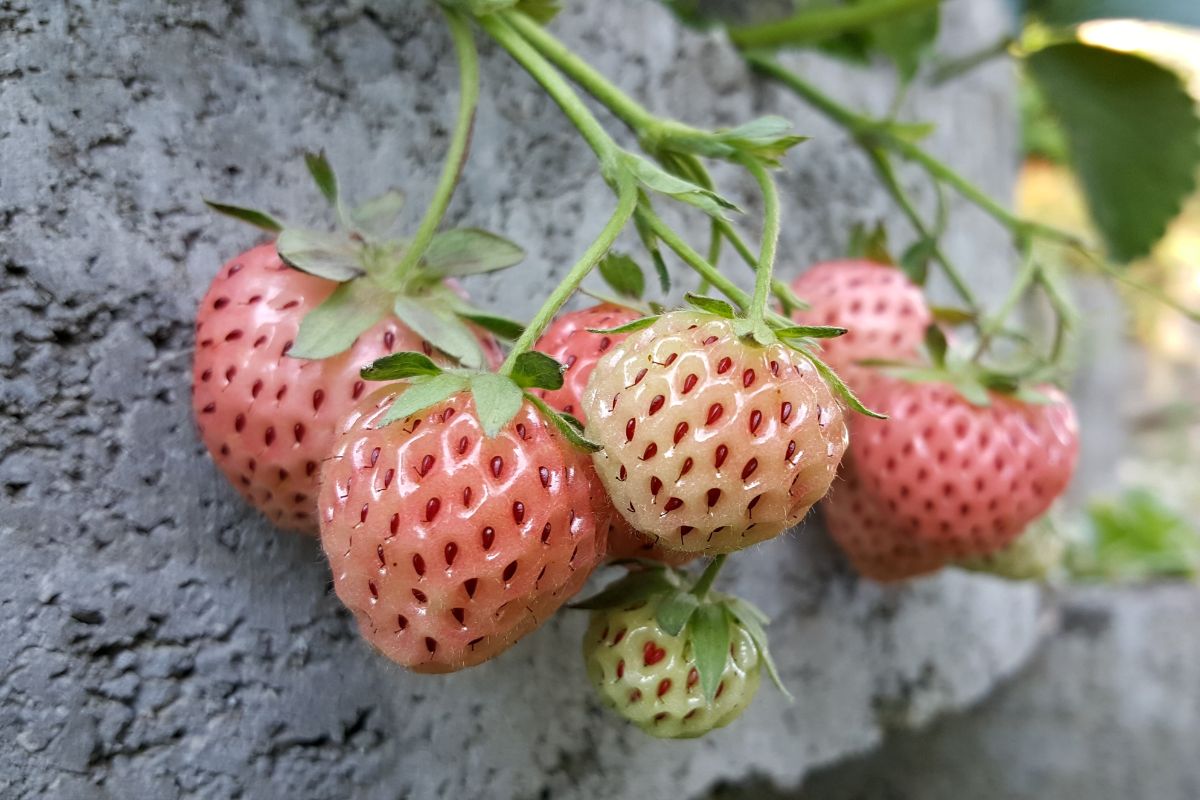
In fact, the specific strawberry variety whose genetics contribute to the striking appearance of the pineberry was “rescued” by a group of Dutch farmers. They discovered the source material in France. They did not find and rescue the pineberry from extinction in the wilds of Chile, as some have claimed. After six years of plant selection and cultivation, the plant vigor and quality of the pineberry plants was improved, and the decision to begin growing them for commercial production was made.
The fruit produced by pineberry plants is very aromatic and has flavor that most say is reminiscent of pineapple while retaining the texture and feel of a strawberry. The pineberry, or pineapple strawberry, is more of a novelty at present. They are produced on a very small scale in Europe and Belize and are not very profitable due to the small size of the pineberries (large pineberries are less than an inch [2.54 cm] big) and the low yield of pineberry plants (see the videos below to better gauge the size of the berries).
Jump to:
Are Pineberries Real?
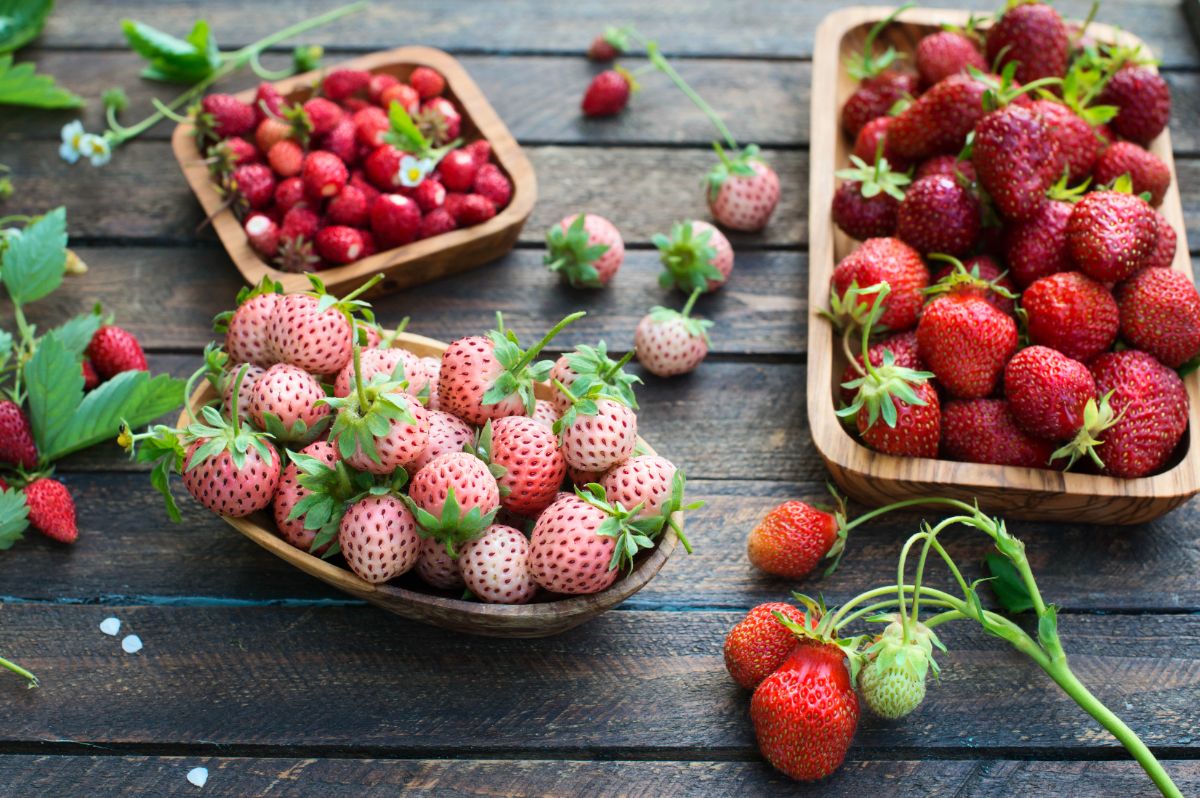
Yes, pineberries are real. The primary commercial cultivar is owned by strawberry breeder Hans de Jongh and the pineberries are sold by VitalBerry BV in the city of Made, Netherlands. Their supplier is Holland’s Beekers Berries who grows them in very large, commercial glasshouses. While the fruits are generally referred to as “pineberries,” the German word meaning pineapple strawberry, “ananaserdbeere,” is occasionally used to reference them as well.
Questions over the existence of pineberries arose after two events cast doubts on their reality. The UK grocery store chain Waitrose was the only supplier of pineberries to the UK market. In the year Waitrose was to initially offer pineberries on a limited basis, they announced the new fruit offering just prior to April 1. Since the store chain had previously run “April Fools” ads for an obviously made up “pinana” (a pineapple banana), many assumed that the pineberry was a similar joke. Additionally, a search engine optimization company adopted Pineberry as its name just prior to the Waitrose announcement. The pineberry products showed on the SEO company’s sites were clearly not real products. These two concurrent happenings led to much skepticism and doubts about the existence of such pineapple strawberries.
Pineberry Informatio
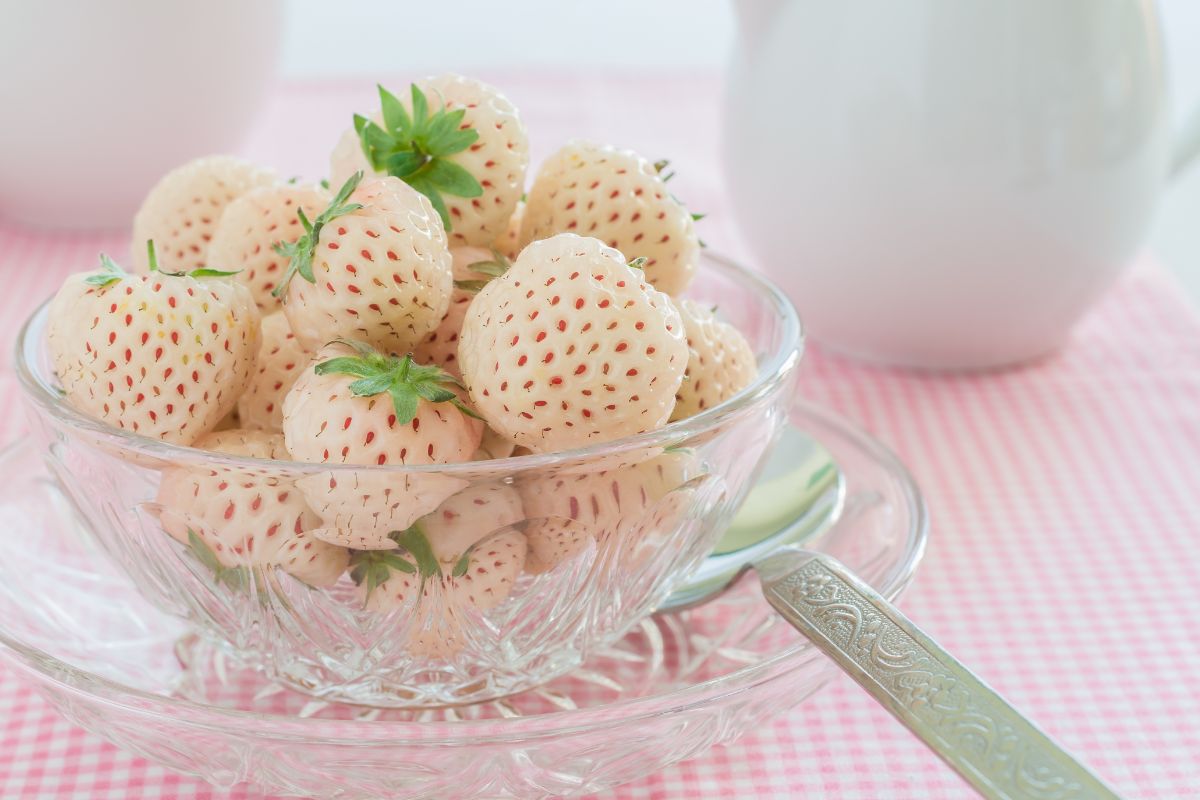
Commercial pineberries are only available for a period of about five weeks. If demand increases, production will likely rise to meet the demand. However, they have been sold in the UK in forty-five Waitrose stores in the past. They generally sold for £2.99 to £3.99 (approximately $4.50 to $6.00) for a 125 gram bag (4.4 oz).
In 2012, pineberries were imported into the United States for commercial sale for the first time. They were available in New York from early May until mid-June. They were available in New York at Dean & DeLuca, Eataly, and Agata & Valentina. They were available for $5.99 per half-pint until after the middle of May, at which time the price increased to $7.99 for the same quantity.
While likely not identical to the pineberry, some Chileans claim that their native strawberry plant is the same as the pineberry. In Chile, this fragrant fruit is referred to as Frutilla Chilena.
While the official promotional materials laud the pineberry as a heavenly taste experience, some food critics aren’t as high on the newly commercialized designer fruit. It’s flavor has been referred to as watery, nippy, and tasting like an unripe strawberry. However, like most things, taste preferences are highly subjective, and there are equally numerous positive taste experiences on record. So, judge for yourself. The pineberries themselves are not widely available commercially in the U.S.A. yet, but they will likely be sold again in the United Kingdom next year. You can, however, buy your own pineberry plants by using the links below.
Varieties of Pineberries
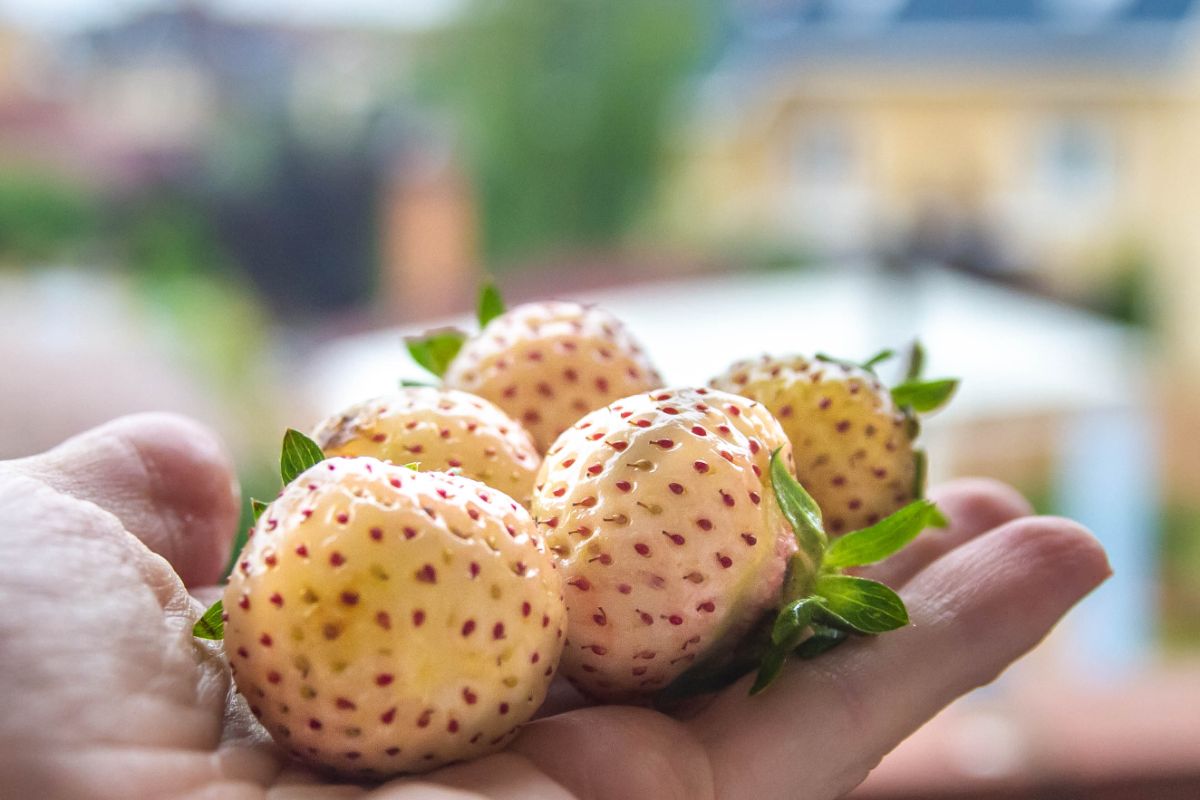
Pineberries have been researched and developed an infinitesimally small amount compared to the common Garden Strawberry. Consequently, while there are hundreds of unique and productive varieties of your typical strawberry, the pineberry varieties available today are very few in number. The variety cultivated by VitalBerry BV cannot, at present, be purchased as strawberry plants, plugs, or crowns for home growing outside of the Netherlands. However, Beekers Berries’ Berries @ Home is scheduled to begin offering pineberry plants in the United States and Canada in early 2014. More information will be published nearer the time, along with detailed introduction dates and sales channels. The pineberry varieties that are available are the ‘White Pine’, ‘White Carolina’, ‘White D’, and ‘Natural Albino’ cultivars.
The White Pine pineberries are vigorous and will send forth numerous runners. The characteristic red-seeded white strawberries are mild and have the pineapple strawberry taste for which pineberries are becoming well-known. To maintain the pale white appearance of the fleshy accessory tissue of the pineberries, it is a good idea to grow them in a glass house or other growing system. The taste won’t be noticeably different, but full sun will cause a bluish-pink hue to tinge the fruits.
A less stereotypical pineberry variety is White Carolina. The pineberries exposed to direct sun will usually have a more evident pink flush than the others. Additionally, this variety is very susceptible to leaf scorch and will likely require fungicides to control it. Organic fungicides may or may not be sufficient to keep it in check. This variety will likely be replaced if and when pineberry research develops more hardy cultivars.
White D pineberries were developed in Sweden and have a bright future. There is the possibility that the genetic traits that dictate strawberry production have endowed this variety with everbearing properties. Should that prove true as testing continues over the next few years, this variety would likely become the most preferred one, at least until superior cultivars are developed. Another positive factor in favor of this pineberry is its fruit size. While still considered small, its berries are generally larger than the pineberries of the other available varieties. The aroma of this variety of pineberry is exceptional and the pineapple flavor is mild.
The newest pineberry variety that has reached commercial availability is Natural Albino, a variety patented by and sold by Nourse Farms. The berries still carry the distinctive aroma and pineapple-y taste that is sought after, however, the fruit is quite small: only about the size of a dime or a nickle. Additionally, this variety requires cross-pollination with a compatible strawberry pollinator in order to set any fruit. Nourse Farms sells the Sonata variety along with the Natural Albino plants in a 1:4 ratio.
Growing Pineberries
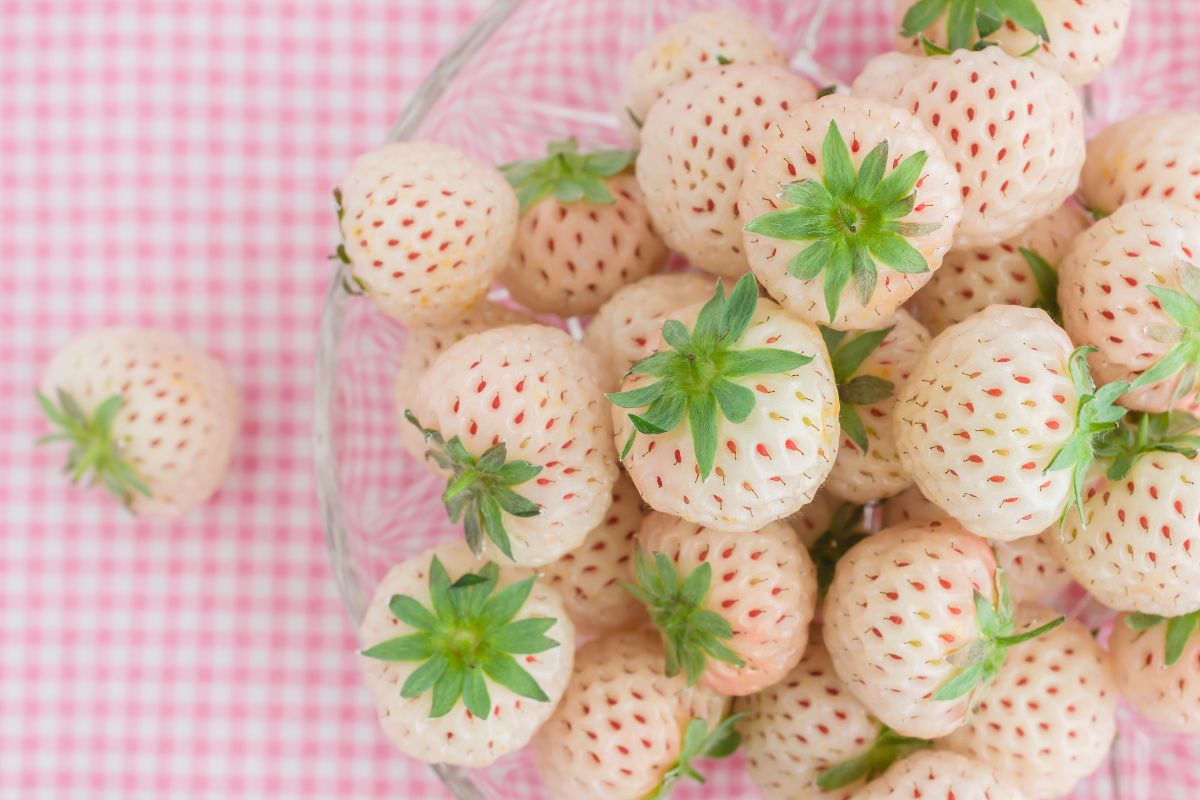
How do you grow pineberries? Pineberry plants are grown just like regular strawberries are grown, with one distinct difference. In order to produce the largest possible crop of the distinct white fruits, it is necessary to have a pollinator strawberry in close proximity. For every four plants, it is best to have one regular strawberry plant for pollination purposes. The early results indicate that the Sonata variety is the best pollinator for pineberries in general, and specifically the Natural Albino variety. For more applicable help, go here: growing pineberries, strawberries.
Where Can You Buy Pineberry Plants?
At present, you can’t purchase the commercial pineberry plants to grow in your garden directly from VitalBerry. However, you can buy the Natural Albino variety from their authorized plant supplier, Beekers Berries, through their Berries @ Home storefront. For other suppliers in the United States and Europe, visit the links below…
Pineberry Plants for Sale – USA
Plants producing the most famous and prototypical pineberry (the white strawberry with red seeds), are available for sale here in the USA. At present, sales are offered seasonally. If they aren’t available or the links aren’t active below, check back in a month or two. Additionally, the plants tend to sell out quickly.
Disclosure: This article includes affiliate links, meaning I get a commission if you make a purchase through my links, at no extra cost to you. As an Amazon Associate I earn from qualifying purchases.
Here is the list of suppliers from whom you can buy pineberries in the USA:
1. Hirt’s Gardens
2 Nourse Farms
3. Burgess Seed & Plant Co.
4. Park Seed Co.
5. Kelly Nurseries
6. Exciting Gardens
7. Hartmann’s Plant Co.
8. Stark Bros.
Pineberry Plants for Sale – UK / Europe
For Europeans, it will likely be easier to buy pineberry plants directly from a European country. For EU or UK pineberry plants, you can purchase them by from any of the suppliers in the following list.
Here is the list of suppliers from whom you can buy pineberries in the UK / EU:
1. Suttons Seeds
2. Lead the Good Life
3. Crocus
4. J. Parker’s
5. MowItSowItGrowIt
6. Berries @ Home
7. YouGarden
8. Telegraph Garden Shop
9. Gardencentre Koeman
10. plantes-et-jardins.com offers Fraisier Anablanca (which listed as Fragaria vesca but appears similar to either the White D or White Carolina varieties mentioned above) and Fraisier Ananas (which may be like the typical pineberry, White Pine) for sale online.
While not having the exotic pineapple strawberry taste of the pineberries, there are a actually quite a few varieties of white strawberries available. You can buy varieties many white strawberry producing plants from suppliers listed in our directory of Strawberry Plants for Sale. Also, non-pineberry white-strawberry-producing plant seeds can be purchased from several suppliers through the directory link in the next section. (or, click here to shop and Buy Strawberry Plants by variety)
Where Can You Buy Pineberry Seeds?
Presently, I know of no suppliers who offer pineberry seeds for sale. Pineberry plants for sale can be found at the links above, however, and the pineberry seeds can be saved from the fruits you harvest. However, since the pineberry is a hybrid strawberry, it is very unlikely that plants directly resembling the parent plants will be grown from saved seed. So, if you really want a typical pineberry experience, buy one of the plants, not seeds. For seeds of other hybrid and non-hybrid varieties of strawberries, visit our directory of suppliers who do sell Strawberry Seeds. For more information on pineberry seeds, see Pineberry Seeds for Sale.
As a cautionary note, purple pineberry seeds will not grow any sort of strawberry plant. ‘Purple Pineberry’ is a specific cultivar of marijuana. So, ordering and growing purple pineberry seeds off the internet may gain you unwanted attention.
Pineberries: Conclusion
The pineberries available today are quite soft when ripe and do not hold up well to shipping. In fact, the inability to keep them in a “fresh” state from the growing location to the store is the primary reason you likely can’t find them on shelves near where you live. Home gardens are, therefore, likely the best place to grow them. Often, the care and nutrients received outside a commercial setting produce better fruits, as studies on growing organic strawberries are showing.
At present, the varieties of pineberries that are available do not produce high enough yields or big enough berries to gain widespread acceptance and heavily penetrate the commercial markets like the pineberry’s red-fleshed relative has. However, as they have now been re-introduced, new varieties will likely be bred. If the characteristic flavor is maintained while the size, yield, and firmness increase, those pale pineberries could have a bright future.
For a video that shows the shape and size of pineberries, as well as the relative quantity you can expect from healthy plants, watch this video:
More:
Pineberry & pineberries, hooray!

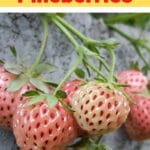
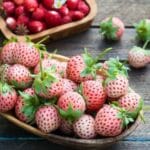
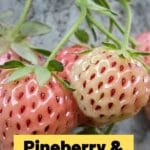

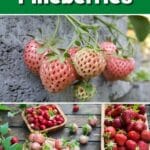
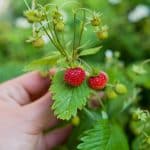

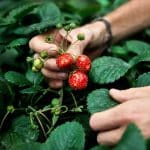
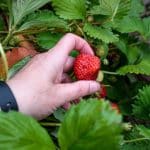
Nathan says
You can find many rare seeds at Athena Garden. They are awesome!
https://athenagarden.org
Hank says
Thank you for the post! I planted White Carolina pineberry last winter (zone 9) and they have grown very well, sending runners every where although I snipped most of them. They haven’t produced much flower though. I wonder if White Carolina is everbearing or june-bearing? You mentioned most of the pineberry varieties are june-bearing. However, some website selling White Carolina claiming it’s an everbearing variety.
Also, I noticed White Carolina is growing higher ~ 16 inch than other strawberry varieties I planted (seascape, san andrea, albion) ~ 8 inch. Anyone else seeing the same thing?
Joey Wight says
Hey got a nice patch going from one plant tons of runners how do i protect them for winter so i dont loose my hard work
Paula says
Hi. I live in Newfoundland Canada. I planted the pineberries last year. They didn’t flower. Instead I had a lot of runners…to the point they got out of control and I had way too many plants. I think I had too many runners and crowded my garden and that’s why I didn’t get any berries.
I have it cleaned up now and have a lot of healthy plants, Should I be snipping off the runners next year to encourage flowering?
Mr. Strawberry says
Paula,
Possibly. The flowers for next spring actually start forming this fall as perennating buds in the crowns of the plants. So, to get the most and biggest berries next year, you need to allow the plants the most development time this fall before the weather induces dormancy. However, overcrowding definitely affects the size of the strawberries also, so try to keep the plants at a ratio of about 3 per square foot, maximum. Good luck!
Cheryl says
Hi. I bought what I believed to be Pineberry plants last year. They didn’t fruit but I got lots of runners, all of which survived the winter. This summer the fruit did appear but it didn’t look white like those pictured. The inside was white but the outside was light red and not very attractive. The taste was pleasant though. Wondering if I’ve been sold the wrong plants.
Mr. Strawberry says
Cheryl,
It is probable that you actually did get pineberry plants. Pineberries themselves will blush pinkish-to-light-red or even light orange with direct sun exposure. So, unless your berries were completely shaded from the sun by the leaf canopy, your berries were probably normal. Good luck!
Andrew Waldegrave says
I am on Vancouver Island Canada
I read that Hula berry seeds will not grow , Fact Lies, I read that they will not have berries , Fact Lies, ,The berries have started grow in year 2, In the next month or two , I will find out I have a real hula berry from seed
Mr. Strawberry says
Andrew Waldegrave,
Keep us posted with your results! Good luck!
Corrie says
Good day.
I am in South Africa and would like to get hold of these strawberry plants. How would you be able to assist?
Mr. Strawberry says
Corrie,
Unfortunately, it can be difficult to get plants shipped internationally due to restrictions and customs policies. Your best bet is to check with your governmental customs office and see if it is possible first, and then see what is required. Once they tell you what you must do or have done, you can contact any of the companies/suppliers listed on this page and see if any will work with you to get the plants you’d like shipped to you. Good luck!
Sam says
Hi,
I noticed a couple of the stores you linked to sell the “Wonderful” variety of the Pineberry. However, that variety isn’t discussed above. What do you know about it? Two of the sites claim it is self pollinating but will give bigger yields when planted with a red.
Any ideas about the flavor, hardiness, or other important facts?
Thanks
Mr. Strawberry says
Sam,
The “Wonderful” pineberry is simply a trademarked version that allows stores to market it more effectively. The claim about a higher yield with a pollinator is accurate. The flavor is that of a normal strawberry with light pineapple overtones. It will grow where other strawberries will, but anecdotal evidence would indicate that it doesn’t do well south outside of Zone 8 or north outside of Zone 3. Hope that helps!
judy says
what do I do with the runners. Planted 8 plants this year and no yield but the plants are healthy there are lots of runners
Mr. Strawberry says
judy,
You can either snip them off or root them to multiply your plants for next year. Good luck!
Snakeyes says
Directed to Mr Strawberry
Is the pineapple strawberry an ever bearing plant or a seasonal variety?
Our patch had flowers and gave us one cycle and is not producing anymore flowers.
Normal???
Thnx
Mr. Strawberry says
Snakeeyes,
Yes, most of the Pineberry varieties are June-bearing. So, they’ll give one big crop and then be basically done for the rest of the year. Good luck!
Carolyn says
Hi,
Having had a problem with mice and ground grown red strawberries, last year I grew them in hanging baskets.
This year I am trying pineberries.
Please could you advise on best growing conditions for these in a rural area accessible to mice? (eg ground/hanging baskets/
raised bed/containers)
Many thanks
Mr. Strawberry says
Carolyn,
The best option is to keep them away from hungry critters, so if you can keep them suspended where the vermin can’t get to them, that is probably your best bet. Or, try to exterminate the mice. Good luck!
Julie says
Can’t you freeze pine berries and can or dry them like blueberries and strawberries too?
Mr. Strawberry says
Julie,
Yes, but once they thaw they’d be gooey mess, just like regular strawberries. And, since they are soft, they need to be frozen soon after picking. Good luck!
Julie says
And what do you use to keep the birds out of your berries???
Mr. Strawberry says
Julie,
This! Good luck!
Julie says
will Pine berries grow in Alaska like in Anchorage and
south of Anchorage in the Kenai Peninsula?
Mr. Strawberry says
Julie,
They should. Good luck!
mike says
thanks Mr. Strawberry.
I have had these plants for a while now (3 weeks) they were doing well in the Sun, growing leaves… but the new plant I got a week ago might have had a problem and it has white stuff on the leaves, which is affecting the other plants. SoI sprayed the serande fungicide on it. It still has those white patches….. and now all the plants doesn’t look too well with brown patches and shriveled leaves, do you think the spray is killing the plant?
Thanks
Mike
Mike says
Hello everyone, I apologize in advance if this is not the correct thread to ask this question.
I got a couple strawberry plant the new Pinberry (white pineapple strawberry). They were doing fine until I decided to buy another one and then the leaves started to turn white patches.
I think it is a fungus of some sort. So I sprayed the Seranade garden spray on the plant 2 days ago. I don’t see the white stuff going away, but the leaves now are turning brown.
Can anyone help to see if I can save the plants?
Thanks
Mr. Strawberry says
Mike,
It sounds like sun scorch. A lot of times plants coming from nurseries or mail-order or big box stores like Lowes or Home Depot will have the plants shaded or grown in grow houses. Putting them directly outside without first hardening them to the elements will cause something like what you describe. Fortunately, the plants usually survive. Watch carefully over the next few days and see if they start putting out new leaves. If they do, the new leaves should do fine, and the plants should perk back up. Good luck!
john says
Waterloo Region, Ontario, Canada: April 30, picked up 8x 4″ pots at $8 CAD + tax at Lowes fresh off the shipping pallets, for a bed start. Heavy artificial fertilization obviously done to them, and they have some flowering and runners starting.
It is called and marketed as “Wonderful Pineberry™”, and from the trade marking (claim at this time), and some basic research, appears to be “Fragaria chiloensis x virginiana”
Inventory number 667147
http://plantguide.lowes.ca/plant.aspx?code=L27206
Some apparently for less nearby @ $4.50 CAD, which I plan to visit to look at them. http://www.whiffletreefarmandnursery.ca/product_p/pine001.htm
Also, I also have found some information from a Missouri university site which makes for interesting read.
http://ipm.missouri.edu/MEG/2015/2/Pineberry-A-Reintroduced-Strawberry/
Mr. Strawberry says
john,
Thanks for the information!
john says
US shipping to Canada is evasive, better for them to say no. Strawberry plant material import to Canada from Continental US is not on the list for needing permits. Except for California to British Columbia, doesn’t need special treatment either. I didn’t see UK in the lists, likely why my recent seed import got held up for inspection.
Oh, and for us Canadians; coming to Lowes.ca in an 11cm pot this spring! Pineberries mentioned in page 9.
Great site here too, thanks!
http://www.inspection.gc.ca/plants/plant-protection/imports/permit-usa/eng/1343427289390/1343427392092
http://www.inspection.gc.ca/plants/plant-protection/directives/horticulture/d-95-08/appendix-1/eng/1322423173660/1322423886642
http://flyers.lowes.ca/flyers/lowes-catalogue?sf_any=true&flyer_run_id=58841&type=2&postal_code=n2n3c1&store_code=2889#!/flyers/lowes-catalogue?flyer_run_id=58841
Aaron says
is there a such thing as a blue strawberry cause i had bought some seeds online and i wanted to know if they would actually grow to be blue?
Mr. Strawberry says
Aaron,
Unfortunately, no. There aren’t any blue strawberries (yet). The pictures you see on eBay and other sites are just photoshopped pictures of strawberries. Sorry!
Andrew Fignar says
Thanks for the info! If anybody wants to see the size from White D, follow the link. Look around a photo of a nice Musk Strawberry too. Man both the Pineberries and Musk are really good eating fruit. They are rather soft. I have been freezing damaged ones for jam, a Pineberry-Musk berry jam, man that is going to be good! I will throw some regulars and alpine in there too. Get some color. As a white jam might not look appealing, but a pink jam would.
Photos can be used here, if you want to. I took them.
http://s128.photobucket.com/user/whitenoise_photo/media/035.jpg.html
I should have cleaned that berry before the photo.
Best photo is of this Musk Strawberry
http://s128.photobucket.com/user/whitenoise_photo/media/038.jpg.html
Mr. Strawberry says
Andrew Fignar,
Thanks for the photos and information!
Andrew Fignar says
This is my 2nd year growing pineberries. White D does seem to be the better choice. berries are large, and a prolific producer. I still have a problem determining when ripe. I noticed some snails munching on a couple of my pineberries! Which brings up a question. Can you leave snail damaged fruits on plant to ripen? Or should one remove them?
OK back to ripeness, being soft is not a good indicator as they become soft before being ripe. At least it seems that way. What I’m doing now is when i think they are ripe, i leave them on one extra day, at least I’m going to try this. i have some about ripe right now. man they look good too! Plants in 2nd year are producing ton’s of berries.
Mr. Strawberry says
Andrew Fignar,
Yes, you can leave mildly damaged fruit on the plant to finish ripening. And, thank you for the information!
Brett says
Hi I had been taking care of pineberry from start boy its been long time to get pineberry I don’t know if I didn’t do right take care of this plant you can see this link website tell me what you think when I bought ebay and then put freeze seeds for 2 weeks then put soil and it finally came grow month wow what take so long nd it grow very slow when I put starter seed with small black box and so slow I gave up take out put upside down as you can see picture and it grow fast the better but it keep long single ahh did I do right thing or is this not pineberry ??
Mr. Strawberry says
Brett,
Unfortunately, even if you did get legitimate seeds from an actual pineberry, pineberries are a hybrid and do not grow true from seed. The topsy turvy planters also are known to have some problems as well. Regardless, good luck!
Jason says
Like you know the red strawberry can make a runner to make a new plant . Can the pineberry do the same ?
Mr. Strawberry says
Jason,
Yes, the pineberry can put out runners as well.
Alliah says
Hi! I just bought 1 pineberry plant and some bare root plants.
I have a couple questions , first when can I plant them outside because the bare root plants are VERY small and I don’t want them to die if it gets down to 30 deg outside.
also, how many would you plant in a 16 in wide 36 in long planter?
and, how many berries are given in one season per plant?
thanks so much!
Mr. Strawberry says
Alliah,
Congratulations! Pineberries can be grown exactly like strawberries, since they are strawberries! Good luck!
Sandy Cortez says
You can find the plants at Mountain Valley Growers in Squaw Valley, CA. I just bought my first plants.
Mr. Strawberry says
Sandy Cortez,
Thanks for the information! I looked them up just a minute ago, however, and they do not have any of the pineberry varieties listed for sale. They do say they offer Albion and Chandler, but those both produce red fruit.
lovelife says
where can u buy them in California??????????
Straw Berry says
lovelife,
The actual berries are difficult to find because they have a very, very short shelf life. The best way to get them is to order plants from one of the suppliers listed above and grow them yourself. Good luck!
mollly says
Mr strawberry:
Thanks for the information. I am not familiar with the commercial production overseas.could you give me some advice about the commercial production. people who planted blueberry once earned a lot of money in china. I just want to got this kind of information. Maybe I can find a potential plant from overseas .Looking forward your feedback. Thank you!
Straw Berry says
molly,
Try starting here: Commercial Strawberry Production. Good luck!
molly says
hello,I am from china. I am very interested in this pineberry. could you give me more information about it,such as
how many plants needed in 1000m2,what is the yield for the area(1000m2).I am considering the possibility of profit in china. So i am very appreciate if you can reply.
Straw Berry says
molly,
In all honesty, you’ll likely do better with a different variety for commercial production. The pineberry varieties that are available at present are relatively small, only produce a moderate yield, and have softer and more easily damaged berries. For commercial production, that means it is very difficult to ship them successfully. If you do try it with the pineberry variety, let me know how it goes! Good luck!
Lois says
Are they organic and non-GMO?
Mr. Strawberry says
Lois,
They are non-GMO, but you will have to check with the supplier to determine if they are grown organically. Most are not grown organically.
Andrew Fignar says
I think Alpines whites taste more like pineapple than pineberries. Although the flavor is quite unique. I have all three cultivars and was wondering if these should be renovated or not?
Mr. Strawberry says
Andrew Fignar,
Technically, strawberry renovation is reserved for June-bearing varieties because they produce one major crop and then are finished for the season. You can, however, still thin the plants and provide them with needed nutrients. Good luck!
WilliamPerez says
It was delicious! I didn’t get pineapple, athough it was tangy. I suppose that could be considered pineapple-y to more discriminating palates.
🙂
William Perez says
how can i tell when pineberries are optimally ripe? i have a plant and one of the berries is white with red achenes above but beige achenes below where the berry is in contact with the soil. there’s only this one berry and i don’t want to eat it if i can wait for it to become more tasty. there are a few other berries but they’re obviously unripe (tiny with beige achenes all over). Thanks!
Mr. Strawberry says
William Perez,
You should wait until the achenes are red to the tip. Also, if they are being grown outside, they will often have a slight pinkish/orange tinge to their white accessory flesh. Ripe pineberries will also be fairly soft, so you should feel some give/softness with gentle pressure.
Ana Barradas says
Hello,
I’m from Portugal, it’s possible to produce pineberries here? We have a lots of strawberries…and i never seen one pineberrie here, i think we have good weather conditions for them.
what should be the best way to start seeds or small pineberrie plants? Where can i buy?
Thanks
Ana
Mr. Strawberry says
Ana Barradas,
If you can grow strawberries where you live, you can grow pineberries. Pineberries don’t grow true from seed, however, so don’t buy “pineberry seeds” anywhere. You can get plants from the above suppliers. I’m not sure what restrictions are placed on vegetative plant life as it crosses national borders within the European Union, but you might be able to get plants shipped to you from one of the suppliers listed above. Good luck!
Lauren says
I should be getting my plant in the mail tomorrow. Can I grow these inside? I live in New Jersey but live in a townhouse with no room for a garden.
Mr. Strawberry says
Lauren,
It can be difficult to grow them inside, but it is possible. If you have a window that gets sun most of the day, put them on the sill there. If they are being shipped to you bare-root, it would be a good idea to put the pot outside at first to assist the plants getting established. Good luck!
Linda says
I recently received a pineberry plant from one of the suppliers listed above. My concern is whether or not growing this plant will affect the fruit of my regular strawberry plants due to cross pollination. I currently have a large bed of everbearing strawberries that produce large, delicious berries in the spring, and a smaller, second, lighter crop later in the summer. I would hate to have my plants start producing smaller, less “strawberry” tasting fruit. thanks
Mr. Strawberry says
Linda,
Fret not! The fruit of your other strawberry plants won’t be negatively affected by pineberry cross pollination. Good luck!
I could live on these things says
I just ran across these today at Central Market. Never heard of a Pineberry but it’s the best piece of fruit I’ve ever eaten. I don’t even like strawberries but these things….WOW!
The cashier asked me what they were so I gave him one as I checked out…he made a sound that was similar to the famous “When Harry Met Sally” scene, just not as loud.
mike says
hi Mr pineberry i want to farm pineberry in kenya. Is it possible?
Mr. Strawberry says
mike,
I’m not too familiar with Kenyan climate, but I think it is probably too hot there to successfully grow pineberries. Sorry!
Ms. Berries says
Can I use pineapple juice, or pineapple extract on white strawberries to sort of create my own version of pineberries?
Mr. Strawberry says
Ms. Berries,
I don’t see why not! Try it out and let us know how it goes!
Stephanie says
I live in Canada (Alberta) Is there anywhere that sells either plants or seed that would be close to me?
Mr. Strawberry says
Stephanie,
I am not aware of any nurseries in Canada from which you can buy pineberry plants at this time. However, I believe the U.S. suppliers listed above can ship to you in Canada. If you do discover Canadian suppliers, please do let me know!
idan ben ruby says
hello, my name is idan and i bought pinberry seeds from ebay. i tried to gertminate them in cotton but no success. how should i germinate them? i rad a little about the importance of d=cold temperture..
thanks.
Mr. Strawberry says
idan ben ruby,
Yikes! I’d recommend reading this carefully: Pineberry Seeds. As they are hybrids, the seeds might not sprout at all, and if they do, they likely won’t look like pineberries are supposed to. See this page for help germinating your seeds: Strawberry Seeds. Good luck!
Denise says
Can i just buy the pineberries without the plant Im looking to buy them by 02/13/13
Mr. Strawberry says
Denise,
Unfortunately, no. They would do great as a Valentine’s Day gift, but they have a very short shelf life, and they do not do well with shipping. They may become commercially available in February if the demand increases enough to make it profitable, but I am not aware of any places where they will be available this year.
Kris Jedlicki says
Mr. Strawberry
We live in Alaska, do you think the pineberries will grow here? To be more specific we live in Anchorage, Alaska we are zone 3 to 4.
Thanks,
Kris
Mr. Strawberry says
Kris Jedlicki,
Yes, pineberries should grow there, but they may require a little extra care to see them through your cold winters. Good luck!
Denise says
hi my name is denise and i wanted to see where i can actually purchase the pineberries i want to get them for 2013 valentines days
Mr. Strawberry says
Denise,
Pineberries were available in 2012 in the United States, but only briefly in New York and later in California. They are hard to come by unless you grow them yourself because they do not ship well. See the “Pineberry Information” section above for the specific locations in New York. They were only available after Valentine’s Day, unfortunately. If you do find them somewhere, be sure to let me know, and I will spread the word!
Kirsty says
So… does anyone in the USA actually supply them? Or would they have to be ordered from different country?
Mr. Strawberry says
Kristy,
They are available in-season from Burpee. At present, they are out of stock. Check back in a month or two, and they will likely be available for ordering for Spring planting again.
Harry says
Hi. Is there an Australian supplier for pineberry plants at the moment or sometime in the future?
Thanks. They sound interesting.
Mr. Strawberry says
Harry,
I am not aware of any Australian pineberry suppliers at present. If I discover one, I will be sure to update and include the information on this page. If you discover one before I do, please do let me know!
José says
Moro em Tapejara-Rio Grande do Sul/ Brasil. Onde posso adquirir essa mudas de Morango/abacaxi? Posso fazer novas mudas com as plantas adultas após os 3 anos de produção delas? e a melhor maneira de produção aqui na região seria em estufa de vido as geadas dos meses de junho a agosto?
Desde já agradeço.
Eng. Agrônomo.
Mr. Strawberry says
Engenheiro Agrônomo,
Eu não sei onde você pode comprar essas plantas no Brasil. Mas, você pode cultivar as plantas filhas deles, se você encontrar um fornecedor. Se você seguir as instruções na página Morangos Crescer, eles devem sobreviver aos seus geadas. Boa sorte!
Scott says
In the available lititure on the “pineberry” it is said that if they receive “excess sun exposure” the fruits will show a blush, yet I am unable to find anywhere what the ideal lighting is.
Mr. Strawberry says
Scott,
It is actually only the pineberry itself that needs to be kept from extensive sun. The foliage of the plants should receive full sun for optimal production. If the berries themselves are not adequately shaded from sunlight, the naturally-emitted spectrum of electromagnetic radiation from the sun will cause the blush in the berries. If they are adequately shaded by the foliage (which blocks the direct sunlight), or if they are grown indoors, they will be white.
Mary G says
I live in growing zone 6b of the USA. Are the plants hardy this far north, or would I have to grow them in a hot house?
Mr. Strawberry says
Mary,
Pineberry plants will grow just fine in Zone 6b. You will not need a hot house. Good luck!
Vincent says
I think that concept of a pineapple being cross bred with strawberry is a fantastic and interesting idea! The plant however is a little expensive for any of us American gardners!! They are 9.99(pounds/Euros) for 2 plants, So for Americans to buy these plants it would cost us roughly 20.00 us dollars for 2 small plants with no guarantee they will grow here!
Mr. Strawberry says
Vincent,
I wouldn’t recommend to people in the United States that they buy them from the UK. Try buying them from a retailer in the United States, like Burpee.
brandon says
can you grow pineberries in an artificial environment such as kansas or texas? if so could i buy the seeds and then plant them in a pineberry green house? what do you reccomend for a climate as such?
Mr. Strawberry says
brandon,
You can grow pineberries in an artificial environment in states like Kansas or Texas. However, they will likely perform more poorly than they would in their preferred habitat. However, see the Pineberry Seeds page for more info on why you can’t get the seeds to plant.
Audrey says
My boyfriend is deathly allergic to pineapple (formerly his favorite fruit). Does anybody know if these would be safe for him to eat if I could get my hands on some? Are they genetically linked to pineapples or do they just have a similar flavor?
Mr. Strawberry says
Audrey,
Be sure to only try it under the supervision of a medical professional; but, he should be able to eat pineberries. Genetically, there are no pineapple genes in a pineberry. They are Fragaria x ananassa and not at all related to the pineapple, despite the pineapple-reminiscent taste.
Jacob Anthony says
I am so upset by this news; they look/sound delicious! A born New Englander living in Sunny Tampa Florida; surrounded by boring strawberries and oranges! These will surely demand increase in sales/profitability but I’m not sure how long I can wait! Im also curious how said companies won’t ship seeds just due to fear of unhappy customer basis but how can they guarantee that there said whole plants will produce perfect pineberries? If only the mother hybrids are the “perfect” mix, how are they selling what I assume are clones if the genetics will obviously have traits battle for berry taste/color? Does that make sense?…Regardless…I hope someone in the U.S. gets on this ever so urgent Pineberry Crisis 🙂
Mr. Strawberry says
Jacob,
The seeds are hybrids and won’t grow true. So, if you plant a seed from a pineberry, there is no telling what will grow out of the ground. It may look similar to a pineberry…or not. It may taste like a pineberry…or not. There is simply no way to tell. So, since people who purchase plant seeds usually do so expecting that what comes out of the ground will look like the fruit from which the seed came, the reputable seed sellers won’t sell them. The pineberry plants sold by the suppliers on this page are indeed clone plants. If you plant them, they will grow up to be just like their parents: pineberries. As they become more popular, more nurseries will sell them. We just have to be patient!
brandon says
Can you buy actual pineberries online and have them shipped to you house because i live in a climate not suitable for pineapples or strawberries, and when do you think they will be commercially avaiable?
Mr. Strawberry says
brandon,
Unfortunately, you can’t buy the actual berries from pineberry plants and have them shipped to you. Strawberries are notoriously bad shippers and have been bred extensively by the strawberry industry for traits that allow them to hold up better. Pineberries are new to the commercial scene and have not been selectively bred nearly as much for those qualities. If you were to order the actual pineberries and have them shipped, they’d likely be smooshed, bruised, and/or moldy by the time you got them. I’m sorry! If demand increases and profitability rises, varieties will likely be developed that are more suitable to commercialization.
ufuk says
Where or how can i buy hybrid seeds from the white strwberrys?
I think there must be one or some seeds producer that produced the seeds from the pineberry?
Mr. Strawberry says
ufuk,
The hybrid seeds will not grow true. In other words, if you were to buy and plant hybrid seeds from white strawberries, you would likely get plants with completely different traits than the parent plants. They might not even produce white berries. So, reputable dealers don’t want to deal with the people who don’t understand what they are buying (thinking they will get white strawberries and identical plants from seed). Consequently, they aren’t for sale. See the Pineberry Seeds page for more details.
colin says
UK Ideal World and GardenBargains.com supply the plants in 9cm pots
Mine arrived today
price £14.99 + £4.99 P&P
Tammy says
All of the above links say that they cannot be shipped the California, USA. Do you know why?
Thanks
Mr. Strawberry says
Tammy,
California is the biggest strawberry producing region in the USA, which is the biggest strawberry producing region in the world. Strawberries in California are a multi-billion dollar per year industry. As this is the case, the legislature is under pressure to not allow any threat to the industry into California. Consequently, it is not allowed for potentially contaminated plants to be shipped in since there is no way to ascertain that each shipment is disease-free and poses no threat.
Mr. Strawberry says
jenn,
If you look above in the “Where Can You Buy Pineberry Plants” section, you will see links. Each of the links in that section will take you to websites where you can order pineberry plants to grow yourself. Presently, that is the only way to obtain the actual pineberries in the U.S.A. They are not yet offered commercially.
jenn says
I live in the United States…how can I get them here?